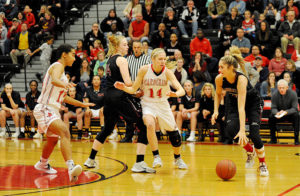The seven ‘S’s of the pick-and-roll
For decades, coaches at every level have regarded the pick-and-roll as arguably the single most efficient offensive tool in their playbooks. Regardless of the offensive set, a well-executed pick-and-roll is effective and can create an array of scoring opportunities, while forcing opposing coaches to make unwelcomed adjustments within their defensive schemes.
 As it’s now the cornerstone of most professional, collegiate and high school offensive systems, team practices and individual skills workouts are tailored to include high repetitions of various pick-and-roll actions, particularly in the role of the ball handler. While there is a mutually beneficial relationship between the ball handler and screener, it’s the ball handler who dictates the action before, during and after the screen.
As it’s now the cornerstone of most professional, collegiate and high school offensive systems, team practices and individual skills workouts are tailored to include high repetitions of various pick-and-roll actions, particularly in the role of the ball handler. While there is a mutually beneficial relationship between the ball handler and screener, it’s the ball handler who dictates the action before, during and after the screen.
They are:
- Survey. Read the defense from far to near.
- Start. Will I need to use my speed or length/size to engage my defender below the level of the screen?
- Setup. How will I get to the screener’s outside foot before my defender to successfully use it?
- Seal. No space can be allowed or compromised to let my defender bridge between my attack and the screen. Close the gap by attacking the screen shoulder-to-hip.
- Separate. The greater the distance covered after sealing off the screen, the greater the chance a player will find an open shot or create a mismatch.
- Sag/soft/switch. How is the screener’s defender playing the pick-and-roll?
- Score. The purpose of the pick-and-roll is to create scoring opportunities. Maximize its potential by staying aggressive at all times.
Survey
The first three steps of an effective pick-and-roll can be likened to a race to the screener’s foot. Within the context of the pick-and-roll, he who reaches the screener’s foot first is more likely to win. Of all tools vital to a ball handler, vision is of the utmost importance. However, we do not lean solely upon vision in its traditional meaning when conceptualizing its use within the pick-and-roll. Rather, we extend its use to include basketball foresight.
Before engaging in the pick-and-roll — particularly in side and spread pick-and-roll — the ball handler should always quickly scan the floor far-to-near to locate shooters, cheating defenders and the defensive position and readiness of his screener’s defender. This snapshot of the floor not only affords the ball handler the opportunity to better acquaint himself with the orientation and spacing of players on the floor, but also how much space he or she will have or need to create before, during and after their use of the pick-and-roll.
Start
It’s often said, “It’s not how you start, but how you finish.” However, in the pick-and-roll, the strength of the ball handler’s start is what leads to a strong finish.
The ball-handler’s start varies by size, speed, strength and skill. Taller ball handlers may prefer to utilize their length and size by using a crab dribble or backing down their defender, while shorter, quicker guards are more likely to face-up and utilize their speed. All guards should be comfortable utilizing both speed and size, as the pick-and-roll is an effective tool against a variety of on-ball defenders.
Setup
The last and most important step in the “race to the screener’s foot” is that of the setup. The ball handler should have at least one move he or she uses to move below the level of the screen. Each set-up move should be accompanied by a counter should the defender ice the ball handler.
Efficient setup moves are precursory essentials to ensure the ball handler a straight-line attack to the screener’s foot.
 Seal
Seal
After winning the race to the screener’s foot, it’s imperative that the ball handler not allows their defender to recover by rubbing the screener’s shoulder with their hip. This ensures there is no space for the ball-handler’s defender to bridge the gap of the screen, subsequently forcing the screener’s defender to make a tough decision. This decision affects the entire team, as each defender would have to rotate to prevent the offense from scoring.
Sag/soft/switch
Determining how the screener’s defender plays the pick-and-roll is the most important read the ball handler must make within the sequence of the pick-and-roll, as it determines how the ball handler most effectively puts his or her team in a position to score.
Will the screener’s defender sag off, soft-hedge or hard-hedge, or switch? Each action by the screener’s defender calls for a complimentary reaction by the ball-handler.
Separate
After an effective seal of the on-ball defender and read of the screener’s defender, the ball handler must separate from the screener. The farther and quicker the separation from the screen, the more indecision the ball handler imposes on the screener’s defender.
For the average ball handler, this requires at minimum two explosive dribbles past the screener. Craftier ball handlers at the highest level of play use as many dribbles as is required to pull the screener’s defender away from the screen to create easy scoring opportunities for themselves or their teammates. Regardless of the number of dribbles — the fewer the better — separation from the screen is imperative to impose unwanted defensive rotations leading to poor closeouts and easy baskets.
Score
The goal of any offense is to score. The ball handler should always be aggressive, utilizing the pick-and-roll as a weapon to facilitate scoring opportunities for themselves and their teammates. The pick-and-roll facilitated by a passive ball handler is as useless as car without keys.









